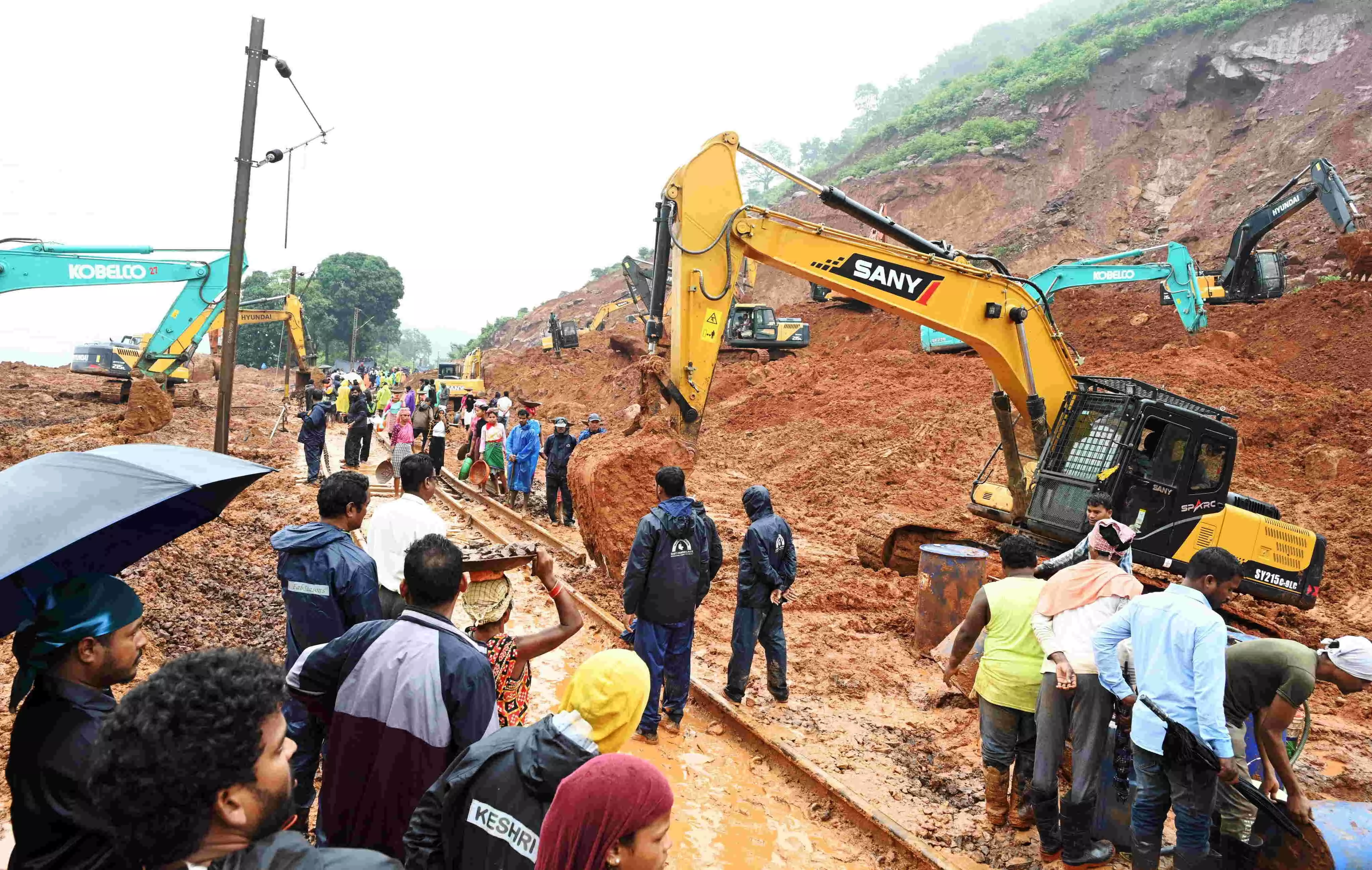Thrice In A Row
Monsoons have been bringing sodden annual death to India’s mountains. Once sanctuaries of pilgrimage and peace, Indian hills are turning into burial grounds

“Rain doesn’t always whisper
poetry. Sometimes it just falls,
simple and honest, reminding us
of life’s unspoken moments…”
— EE Cummins
The first wake-up-or-die warning of nature’s wrath on mankind lashed the mountainsides of Himachal Pradesh in the shape of cloudbursts, incessant thundershowers and howling winds in mid-July 2012. I read about it in my Delhi home and sighed—I had returned from Manali just the day before. Over the next few days, the rain-Gods’ ran amok, fury unchecked. Entire hillsides came tumbling down, rivers broke their embankments, iron bridges were uprooted from their foundations as if made of toothpicks, and people swept into the raging waters and rushed to downhill doom in record time. A week later, the rains hit again. This time, Uttarakhand, Kerala and the Northeast weren’t spared either.
A partaker of all things Bacchus at that time, I nursed a whisky and shoved my SUV into ‘Drive’ one late evening—it was time to take a closer look. By sunrise, I was in the hills. The pictures and visuals I had seen on social media and TV were nothing compared to the mayhem and deathliness that bespoke the silent screams of our protesting hillsides. The majestic spines of Himachal, Uttarakhand, Kerala and Northeast had creaked and collapsed under the onslaught of rain, exposing fractured systems. This was not inclement weather, but war—a raging battle against our recklessness and stoic indifference.
That 2012 day, I realized that monsoons weren’t romantic anymore. They were tragic, bringing boggy annual death to the mountains. Once sanctuaries of peace and pilgrimage, hillsides were turning into seasonal burial grounds, zones of horror. Places that once offered cool shade and spiritual calm now echoed with the sound of collapsing homes, weeping families and the mechanical churn of earth-movers clearing debris from landslide-hit sections. India and Indians had managed to conjure up a lethal story of abandonment, decay and corruption—all stemming from nonchalance and neglect.
Some Calm for a Decade
There was calm for a few years, except for the daily skirmishes that hillsides face during monsoons. In 2023, the rain Gods returned to resume their vengeance. Things began getting morbid on July 8, when rains turned incessant and cloudbursts became an hourly phenomenon. The hills began to crumble once more, families vanished in seconds, homes were torn from their very foundations and trees from their roots, while roads split apart and shattered like cracked bones. Entire communities woke up to slush, twisted metal and scattered limbs. Nothing was safe; the green heights had become graves.
Some names stood out (though they are only indicative)—Patlikuhal, Palchhan, Sainj, Karsog, Kasol, Joshimath, Rudraprayag, Garhwal, Chamoli, Rishikesh, Bageshwar, Kashipur, Wayanad, Aizawl, Lakhimpur… In 2023, nature groaned under the vicious impact of reckless human interference in these 15 towns and districts, as it did in hundreds of others. Next year, in 2024, these towns and exactly the same spots again suffered landslides and largescale mayhem, causing massive loss of life and property.
In 2025, the monsoons have not even begun in right earnest, but these names are already back to haunt us. The same spots that saw the most destruction and death in the preceding two years—spots where hundreds of crores were spent to shore up the hillsides and keep the rivers at bay—have collapsed again, the repairs and retaining walls (dangar) washed away. The authorities, entrusted to protect people and the environment, are either playing hard to find or have no answers. For the common man, battling to save his home or the one who has just become homeless, the apathy is not surprising anymore. It is systemic. It is lethal. And it is criminal.
Rain, Ruin and Repetition
This year, 2025, is also a head-scratcher because the monsoon is yet to set in but it has already broken down the door. Ferocious flash-floods have battered Himachal Pradesh, Uttarakhand, the Northeast and Kerala’s Western Ghats, turning forested slopes and quaint hamlets into disaster zones. Landslides have already thundered down the hillsides. Rivers have swollen into monsters. Winds are howling through the valleys, carrying with them roofs, vehicles and sometimes entire buildings.
Last week, in a chilling incident in a Shimla suburb, a five-storey building collapsed like a stack of cards. For weeks, the residents had begged the authorities for intervention—reportedly, it was highway four-laning work to enable faster tourist arrivals that had done a ‘Kalidasa’ with their foundations and led to the appearance of warning cracks on their walls. But no help came, and as state officials and their favourite contractors debated on who should visit the site for a dekko, the site itself ceased to exist. It had exposed not just the fragility of the building’s foundations, but the hollow core of governance too.
The overall damage in the mountains is numbing. Roads linking remote communities are gone, bridges lie mangled in riverbeds and power lines dangle precariously. Basic services like water, electricity and communications vanish for days, sometimes weeks. The same is the case with food, medicine and people’s hope(s). Village upon village is mourning its loved ones and the slow decapitation of legacies built over generations. The hills, which once fed and protected the pahadis manus, are now betraying them. But we, as a system, betrayed the hills first.
Soliloquy 1: Who can we blame? That is a tough ask, primarily because the destruction is engineered, not natural. Builders and private contractors have sliced through hills to butter new highways without buttressing adjacent slopes. They have built multi-storey apartments on mushy soil without assessing its load-bearing capacity. They have plundered forests and bulldozed catchments for ‘development’. And every time the rains return, the mountains return the insult—with fury and vengeance. We cannot even call these ‘isolated mistakes’, because they are part of a massive, intentional betrayal. Roads have been widened without runoffs. Drainage channels are blocked by debris. Retaining walls have been built with third-rate materials. And most reconstructed structures, especially those funded by public money, have collapsed with the first onset of rain-showers. Early-warning systems are either absent, malfunctioning or ignored. Evacuation protocols, if they exist, remain trapped in files and policy papers. The people, without exception, have been left to fend for themselves.
Mountains are Warning Us
For a moment, let’s look forget all else and look at the human toll. Till late on Saturday, the official toll was a shade under 100, with Himachal bagging the dubious distinction of leading with 40 confirmed deaths, while scores are missing or injured. Do picture a brutal visual—much of the loss of life happened when hill-folk were sleeping inside their homes. I shan’t even try and sketch out that picture; of what it may feel like to be all tucked in one moment, while the next sees a rage of water sweep your entire home away, you and family and livestock and all.
That macabre sketch would be best saved for the survivors to throw at the authorities, the officials who have been promising for two years that all is well and that India’s mountains are in a “heightened state of preparedness to face the monsoons”. Call me repetitive if you will, but most of the landslides and embankment breaches—especially in and around townships—have happened at the exact same spot where repairs have been carried out for two straight years. You can call me a word-less author too, for I don’t know what epithets or sobriquets I should bestow on those who have so criminally failed to ensure zero recurrence of riverbank-breakages and landslides, at least in the same vulnerable spots. Do remember that thousands of crores of public funds have been spent on this work.
There comes a time when even the most forgiving of landscapes stop absorbing abuse. That time is now. The mountains seem to have decided that enough is enough. They are warning us, showing us a glimpse of what the final punishment can be. If we do not act with urgency and clarity, the hills will continue to collapse—physically, and as symbols of our larger failure. We are staring at a future where monsoons mean massacre, mountain roads a trap and hillside settlements denote a tomb that needs some occupants to complete the grim picture. And as tombs go, the occupants had better be dead.
The writer is a veteran journalist and communications specialist. He can be reached on [email protected]. Views expressed are personal



